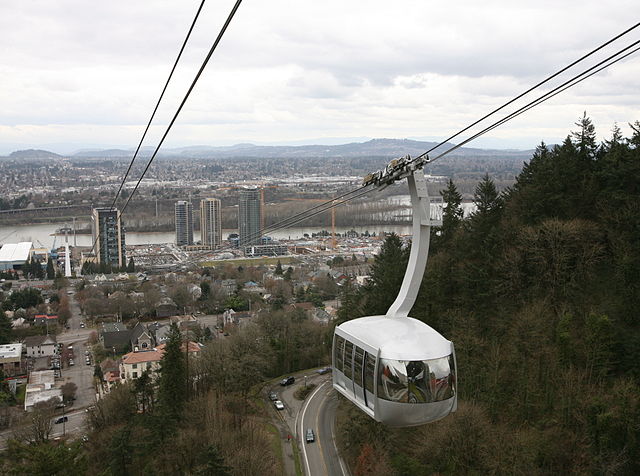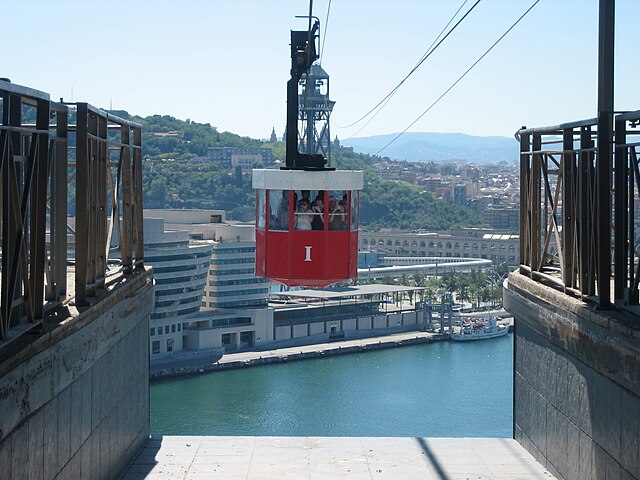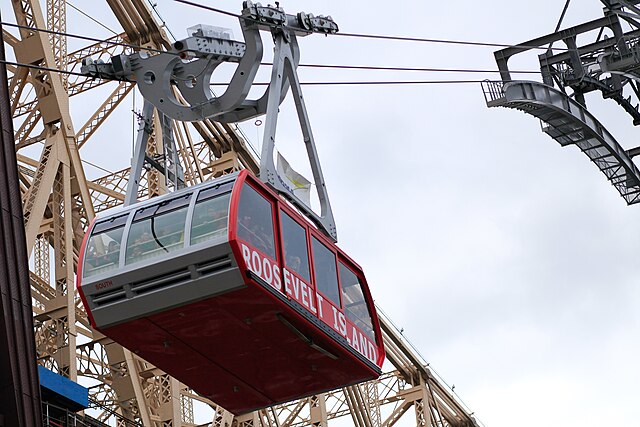Loading AI tools
Aerial lift in which the cars are permanently fixed to the cables From Wikipedia, the free encyclopedia
An aerial tramway, aerial tram, sky tram, aerial cablecar, aerial cableway, telepherique, or seilbahn is a type of aerial lift which uses one or two stationary cables for support, with a third moving cable providing propulsion.[1] With this form of lift, the grip of an aerial tramway cabin is fixed onto the propulsion cable and cannot be decoupled from it during operation. Aerial tramways usually provide lower line capacities and longer wait times than gondola lifts.[2]



Cable car is the usual term in British English, where tramway generally refers to a railed street tramway. In American English, cable car may additionally refer to a cable-pulled street tramway with detachable vehicles (e.g., San Francisco's cable cars). Consequently careful phrasing is necessary to prevent confusion.
It is also sometimes called a ropeway or even incorrectly referred to as a gondola lift. A gondola lift has cabins suspended from a continuously circulating cable whereas aerial trams simply shuttle back and forth on cables. In Japan, the two are considered as the same category of vehicle and called ropeway, while the term cable car refers to both ground-level cable cars and funiculars. An aerial railway where the vehicles are suspended from a fixed track as opposed to a cable is known as a suspension railway.
An aerial tramway consists of one or two fixed cables (called track cables), one loop of cable (called a haulage rope), and one or two passenger or cargo cabins. The fixed cables provide support for the cabins while the haulage rope, by means of a grip, is solidly connected to the truck (the wheel set that rolls on the track cables). An electric motor drives the haulage rope which provides propulsion. Aerial tramways are constructed as reversible systems; vehicles shuttling back and forth between two end terminals and propelled by a cable loop which stops and reverses direction when the cabins arrive at the end stations. Aerial tramways differ from gondola lifts in that gondola lifts are considered continuous systems (cabins attached onto a circulating haul cable that moves continuously).[3]

Two-car tramways use a jig-back system: a large electric motor is located at the bottom of the tramway so that it effectively pulls one cabin down, using that cabin's weight to help pull the other cabin up. A similar system of cables is used in a funicular railway. The two passenger or cargo cabins, which carry from 4 to over 150 people, are situated at opposite ends of the loops of cable. Thus, while one is coming up, the other is going down the mountain, and they pass each other midway on the cable span.
Some aerial trams have only one cabin, which lends itself better to systems with small elevation changes along the cable run.
The first design of an aerial lift was by Croatian polymath Fausto Veranzio, and the first operational aerial tram was built in 1644 by Adam Wybe in Gdańsk, Poland.[4] It was moved by horses and used to move soil over the river to build defences.[5] It is called the first known cable lift in European history and precedes the invention of steel cables. It is not known how long this lift was used. Germany installed the second cable lift 230 years later, now using iron wire cable.[6]
Aerial tramways are sometimes used in mountainous regions to carry ore from a mine located high on the mountain to an ore mill located at a lower elevation. Ore tramways were common in the early 20th century at the mines in North and South America. One can still be seen in the San Juan Mountains of the US state of Colorado. Another famous use of aerial tramways was at the Kennecott Copper mine in Wrangell-St. Elias National Park, Alaska.
Other firms entered the mining tramway business, including Otto, Leschen, Breco Ropeways Ltd., Ceretti and Tanfani, and Riblet. A major British contributor was Bullivant, which became a constituent of British Ropes in 1924.[7]


In the beginning of the 20th century, the rise of the middle class and the leisure industry allowed for investment in sight-seeing transport. Prior to 1893, a combined goods and passenger carrying cableway was installed at Gibraltar. Initially, its passengers were military personnel. An 1893 industry publication said of a two-mile system in Hong Kong that it "is the only wire tramway which has been erected exclusively for the carriage of individuals" (albeit workmen).[8] After the pioneer cable car suitable for public transport on Mount Ulia in 1907[9][10] (San Sebastián, Spain) by Leonardo Torres Quevedo and the Wetterhorn Elevator (Grindelwald, Switzerland) in 1908,[11] others to the top of high peaks in the Alps of Austria, Germany and Switzerland resulted. They were much less expensive to build than the earlier rack railway.
One of the first aerial trams was at Chamonix, while others in Switzerland, and Garmisch soon followed. From this, it was a natural transposition to build ski lifts and chairlifts. The first cable car in North America was at Cannon Mountain in Franconia, New Hampshire in 1938.[12]
Many aerial tramways were built by Von Roll Ltd. of Switzerland, later acquired by Austrian lift manufacturer Doppelmayr. Other German, Swiss, and Austrian firms played an important role in the cable car business: Bleichert, Heckel, Pohlig, PHB (Pohlig-Heckel-Bleichert), Garaventa and Waagner-Biró. Now there are three groups dominating the world market: Doppelmayr Garaventa Group, Leitner Group, and Poma, the last two being owned by one person.
Some aerial tramways have their own propulsion, such as the Lasso Mule or the Josef Mountain Aerial Tramway near Merano, Italy.

While typically used for ski resorts, aerial tramways have come into use in the urban environment. The 1976 Roosevelt Island Tramway in New York City, the 2022 Rakavlit cable car in Haifa, Israel and the 2006 Portland Aerial Tram are examples where this technology has been successfully adapted for public transport.
The telpherage concept was first publicised in 1883 and several experimental lines were constructed. It was designed to compete not with railways, but with horses and carts.[13]
The first commercial telpherage line was in Glynde, which is in Sussex, England. It was built to connect a newly opened clay pit to the local railway station and opened in 1885.[13]
There are aerial tramways with double deck cabins. The Vanoise Express cable car carries 200 people in each cabin at a height of 380 m (1,247 ft) over the Ponturin gorge in France. The Shinhotaka Ropeway carries 121 people in each cabin at Mount Hotaka in Japan. The CabriO cable car to the summit of the Stanserhorn in Switzerland carries 60 persons, with the upper floor accommodating 30 people in the open air.[14]
This section needs additional citations for verification. (July 2008) |




Despite the introduction of various safety measures (back-up power generators, evacuation plans, etc.) there have been several serious incidents on aerial tramways, some fatal.
Seamless Wikipedia browsing. On steroids.
Every time you click a link to Wikipedia, Wiktionary or Wikiquote in your browser's search results, it will show the modern Wikiwand interface.
Wikiwand extension is a five stars, simple, with minimum permission required to keep your browsing private, safe and transparent.